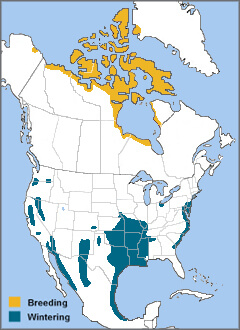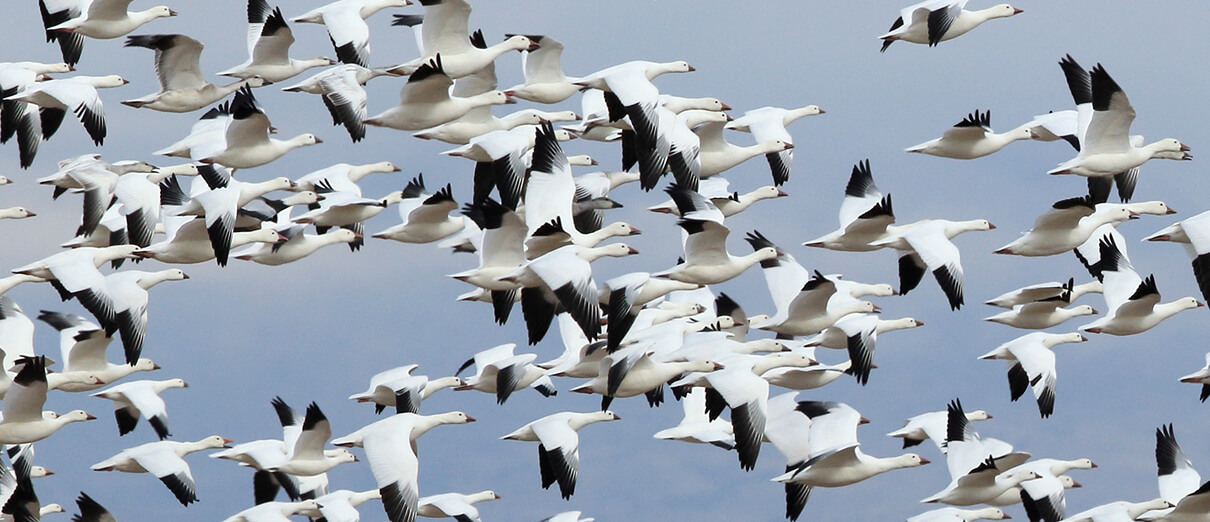
Snow Goose range map by ABC.
Like the Snowy Owl and Snow Bunting, the Snow Goose nests at the “top of the world” on tundra, much of it above the Arctic Circle. This means that from about late March to late October, this is a wilderness bird. This fact, however, is easily dismissed in fall and winter by people enjoying the sight of thousands of gleaming-white birds coming in to land at national wildlife refuges, including California's Salton Sea, New Mexico's Bosque del Apache, Texas's Anahuac, and Delaware's Prime Hook, as well as other wetland areas.
Although one of the world's most abundant waterfowl species, the Snow Goose is regularly seen by fewer people than is the familiar Canada Goose. This is mainly because, as well as being a tundra nester, the Snow Goose tends to concentrate in key migration and wintering spots and thus is not as widespread.
One Goose: Snow Goose, Blue Goose…
The Snow Goose occurs in different plumage colorations, known as morphs or forms. Overall, the most common form has a snow-white body plumage. However, there are many Snow Geese with dark gray-bluish bodies. Ornithologists once believed these birds belonged to a separate species, called the Blue Goose. These birds are now known as the dark or blue morph of the Snow Goose. The white and blue forms readily breed together, and the goslings from a single clutch can be either white or blue — sort of the way humans have brown or blue eyes. In an interesting twist, the Snow Goose retains the former Blue Goose' s scientific name caerulescens … which explains why this often-all-white bird is labeled otherwise in its species name.
Other species with distinct morphs include the Eastern Screech-Owl, the Reddish Egret, a good number of hawks (including, rarely, the Broad-winged), and, very rarely, the similar but smaller Ross's Goose. Although not always the case, there can be a regional aspect to the distribution of color morphs. This is certainly true in the Snow Goose: “Blue” geese mostly nest in the center the species' breeding range, with most wintering in Central U.S. states, and they are the majority of wintering birds along the Gulf Coast.
This situation, however, seems to be blurring a bit. Snow Goose populations have been growing and as the species' wintering range has expanded, populations have been mingling more in recent decades. “Blue” geese are more frequent in the East than they used to be, although they remain a minority of the birds seen there.
In the Snow Goose, there are also “intergrade” plumages between the all-white and dark-bodied forms. The “blue” plumage is genetically dominant, so a “blue” Snow Goose pair will produce young that will grow to have “blue” plumage, but also perhaps some nest-mates will grow to be white-bodied. All-white Snow Goose pairs, however, hatch young that will grow to be white geese. This would not be readily apparent on the nesting grounds, however, because all juvenile Snow Geese start out with dark plumage, including the feathers on their necks and heads.
A Blizzard of Snow Geese
As mentioned before, much of the Snow Goose population breeds above the Arctic Circle. Most nest in Canada, but there are also a few breeding areas in northern Alaska, northwestern Greenland, and in far-northeastern Siberia as well — a continent jump also taken by the Sandhill Crane. However, except for rare strays, all Snow Geese winter in North America.
Migration stopover sites and wintering grounds are “traditional” in that the birds occur in the same places year after year, though they move around farm areas depending upon food availability, and the species continues to expand to new areas as populations grow.
There are two Snow Goose subspecies, the more plentiful “Lesser” and the “Greater,” which is more than five percent larger and winters in the Mid-Atlantic states. This species sometimes hybridizes with its smaller relative, the Ross's Goose.
The Snow Goose's wintering range is broken in pieces: The largest contiguous area runs from the mid-latitude Central states down to along the Gulf Coast as far south as Veracruz, Mexico. Along the East Coast, Snow Geese winter from Massachusetts down to eastern South Carolina, though the largest concentrations occur from coastal New Jersey to North Carolina. Snow Geese also winter from New Mexico south into Mexico's high plains. Along the West Coast, there are at least six wintering zones, separated by mountainous or water-scarce terrain, from the Washington-Oregon border south to northwestern Mexico.
Snow Goose calls sound somewhat like high-pitched dog barks when compared with the distinct honks issued by Canada Geese and the sad-sounding, hooting cries of Tundra Swans.
Listen here:
(Audio: Richard E. Webster, XC598129. Accessible at https://xeno-canto.org/598120 · Nick Komar, XC301952. Accessible at www.xeno-canto.org/301952 · Brian Sullivan, XC135447. Accessible at https://xeno-canto.org/135447)
A Voracious Vegetarian
Snow Geese dine on a wide range of plant foods that vary by location and season. These birds feed both on land and in shallow water, eating roots, shoots, tubers, stems, bulbs, leaves, and seeds, including waste grain and also potatoes left in fields. To sustain themselves on this plant diet, these large birds have to spend a lot of time foraging. All of this activity, done by large concentrations of geese, can have an impact on the birds' nesting habitats in particular, and in some areas may degrade habitat used by other species, including birds such as the Semipalmated Sandpiper and Red-breasted Merganser.
Tundra “Walk-abouts”
The female Snow Goose chooses a nest site on a slight rise in the terrain, from which she can watch for Arctic Foxes and other predators. In a slight hollow, she bunches plant matter and then lines her nest with down feathers. She lays, most often, three to five whitish eggs (although sometimes more), incubating them for a little more than three weeks. Once hatched, the young scamper out of the nest and begin a “walk-about” in search of food. They are attended by their parents. In the six or seven weeks it takes to fledge, the young and their parents often wander for miles in search of food.
The oldest known wild Snow Goose lived more than 27 years; it was banded early in 1974 and shot by a hunter late in 1999.
Wildlife Ambassadors
Today, Snow Geese inspire many people who enjoy the outdoors and cherish biodiversity, from birders to hunters to photographers to general tourists who have never seen such large flocks of gleaming white geese. It was not always that way.

Snow Geese and Ross's Geese (smaller, with shorter bills); photo by Frank Fichtmuelle.
In 1916, Snow Goose populations were so depleted by unregulated hunting that the species was fully protected. Conservation efforts enabled populations to rebound, and regulated hunting has been permitted now for almost 50 years. During that time, the goose population has continued to grow, in part due to an abundance of industrial farmlands littered with surplus grain that fuel the birds as they migrate and winter. In some of their Arctic nesting areas, Snow Geese are now so abundant that their foraging is impacting the health of the vegetation.
Snow Geese share their fragile tundra nesting habitats with many other migratory birds and other wildlife. Although they are now thriving, climate change could dramatically alter their status. According to three climate-change scenarios mapped out by National Audubon Society, the Snow Goose's current breeding range might be cut by 53 percent if temperatures rise by 1.5 degrees Celsius; by 73 percent with a 2-degree change; and by 97 percent if things heat up by 3 degrees Celsius. Although they feed in farm fields, these birds also rely upon wetland habitats, which continue to dwindle, and they also face the threat of collisions with human-made structures such as powerlines.
ABC programs effectively address threats faced by the Snow Goose and many other birds, ranging from collisions solutions to our BirdScapes approach to bird conservation, which aims to conserve habitat across birds' full life cycles.
Donate to support ABC's conservation mission!



















































